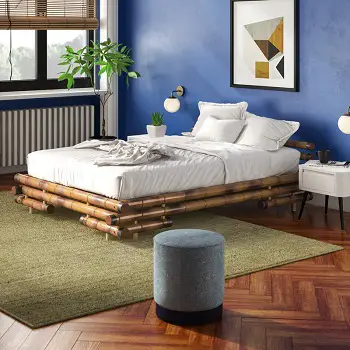Lucky Bamboo has become a popular plant, commonly grown as an indoor plant in homes and businesses.
These are excellent beginner houseplants, with a natural ability to flourish and adapt to different conditions.
They can be grown in a vase or decorative pot and arranged in interesting and elaborated designs like circular and curved forms, braided, or simple bunches, and solitary stalks.
Some believe they hold symbolism, especially if the plants are given as gifts, as they promote happiness, wealth, and wisdom.
What is Lucky Bamboo?
Lucky bamboo, also named friendship bamboo and ribbon plant, is not actually bamboo. Its botanical name is Dracaena sanderiana, from the Asparagaceae family, native to tropical western Africa.
Its foliage is solid green and relatively fast-growing compared to other house plants. Mature lucky bamboo will reach up to 5′ tall with an equal spread.
How to Grow Lucky Bamboo at Home?
Lucky bamboo grows in almost any condition and is really simple to take care of. So, you can find a place for it in almost every room of your house.
To grow tall and healthy plants you should consider paying attention to variables such as good light, filtered water, and appropriate nutrients.
Most commonly this plant is grown in moist but well-drained soil or a glass vase filled with pebbles. Either way, the most important part is ensuring proper drainage to promote strong roots.
To keep the roots moist and healthy use distilled water. Tap water is fine to use unless the tap water contains a lot of minerals.
Water the plant weekly with enough water to cover the roots, but avoid the bamboo stalks from getting wet.
The space between the stalks and the edge of the vessel should have at least one inch, to allow the roots to spread out and support the plant.

Where to Put Lucky Bamboo in Home?
According to Feng Shui, when the lucky bamboo is facing East it attracts good health for the entire family. In the southeast direction, it attracts money and wealth. At the center of the dining table, it boosts positive energy and attracts wealth.
Lucky bamboo creates a sense of balance and safety in life.
Having bamboo plants at home and in the office, brings good fortune, abundance, and prosperity, and they improve the flow of positive energy when it is placed in the right direction.
How to Trim Lucky Bamboo?
Trimming is an important part of keeping a lucky bamboo healthy. Over time, it will become heavy on the top, or the intricated forms will start to lose their form, but trimming will help to keep that under control.
Is not a good idea to cut the main stalk, because it will kill the entire plant, instead what’s best is to cut back the branches short using sterile snippers. New sprouts will soon appear, and the resulting plant will be bushier.
To prevent new growth is possible to dip the cut end in paraffin.
The intricated or spiral designs are not formed by trimming. The stems can be trained to take on several forms including spirals, braids, and loops, by rotating the plant stalks towards the sunlight, which will make the plant grow towards the light.
Doing this at home can be a difficult process that takes patience and time to get it right, paying attention to the growth rates of the stalks and rotating them accordingly, slowly and on a regular basis, creating the shapes and designs.
Why Does Lucky Bamboo Turn Yellow?
Yellow leaves on Lucky Bamboo often show that the plant is receiving too much sunlight or an excess of water. To fix this, move the plant to the shade and reduce the amount of water for a quick solution.
Lucky Bamboo Meanings
For more than 4,000 years Lucky Bamboo has been treated as a symbol of good fortune in the ancient Asian practice of Feng Shui, which believes that the balance of Earth, Water, Wood, Metal, and Fire will bring harmony to environments. Lucky Bamboo stands for the element of Wood.
According to the Chinese tradition, the meaning of the lucky bamboo plant changes depending on the quantity of the stalks, for example:
- One stalk attracts good luck.
- Two stalks stand for love or double luck.
- Three stalks tied together will attract wealth, happiness, and long life.
- Five stalks tied together are the perfect gift to someone who wants wealth in business.
- Six stalks are said to bring prosperity.
There are no traditional lucky bamboo arrangements made from four stalks, as they would be considered offensive, a bad luck present.

Difference Between Bamboo and Lucky Bamboo
The two plants are not closely related, the name of lucky bamboo is given because the stalks resemble the canes of bamboos.
Frequently Asked Questions About Lucky Bamboo
How Fast Does Lucky Bamboo?
Lucky Bamboo grows relatively fast, growing around 19 inches in six months. Normally the indoor plants will grow to a maximum of 3 feet, but occasionally they will grow up to 5 feet.
Does Lucky Bamboo Need Sunlight?
Bright and indirect sunlight is the favorite type of light of this plant. Straight light will burn the plant, and if the plant begins to extend or the green color of the leaves is less bright and solid, it shows that it needs to receive more light.
Does Lucky Bamboo Need Fertilizer?
Lucky bamboo is a unique plant that requires very little nutrients other than freshwater every week, and a single drop of liquid fertilizer (specific lucky bamboo fertilizers are available online), once a month to guarantee a healthy plant.
Does Lucky Bamboo Need Drainage Holes?
If planted in soil, it is important that the container has proper drain holes.
Does Lucky Bamboo Flower?
Lucky bamboo rarely flowers indoors. In nature, the bloom time is in fall and winter, with white flowers.
Does Lucky Bamboo Like Humidity?
Average humidity is fine for a lucky bamboo plant, and because it is a plant from Africa, it prefers warmer temperatures. Avoid placing them anywhere near a hot or cold draft, in front of an air conditioner or a heating vent.
Can You Grow Lucky Bamboo Outside?
It’s possible to plant lucky bamboo in soil outdoors, however cold temperatures or intense sunlight can damage the plant.
Bamboo Group is a collaboration of individuals who love the world’s most sustainable and eco-friendly natural material. We believe every home can benefit from the natural colors and patterns of bamboo. We’re excited to see bamboo grow in popularity and get the recognition it deserves. Years of experience growing bamboo plants have taught us a lot we want to share with the world.



